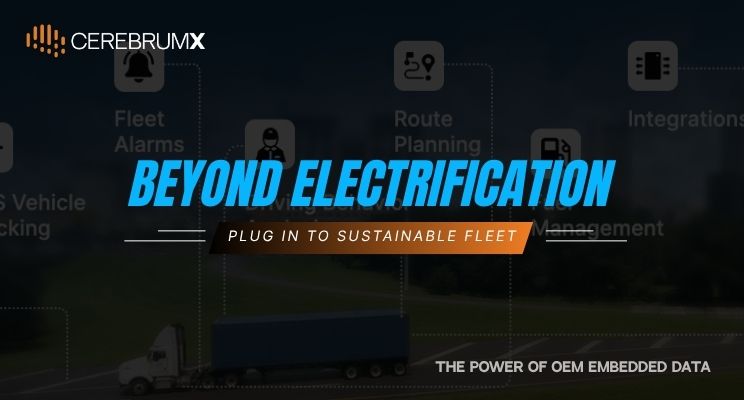For fleet operators, sustainability is no longer a distant, long-term goal. It’s a present-day business imperative. Rising fuel costs, regulatory pressure to cut emissions, and growing client demand for greener operations are all factors driving a shift toward smarter, cleaner fleet strategies. But the path to sustainability isn’t only about switching to electric vehicles or reducing trips. Instead, it begins with data visibility.
With the rise of embedded connected vehicle data, fleets can now monitor key sustainability metrics like fuel consumption, idling time, EV battery range, and carbon output in real time. These insights give fleet managers the clarity they need to reduce waste, optimize efficiency, and move decisively toward a lower-carbon operation, without compromising performance or profitability.
Why Sustainability Needs to Be Data-Driven
Sustainability in fleets has historically been approached through broad measures, like fleet electrification, route optimization, and driver training. While these are essential steps, they only succeed when backed by precise, vehicle-level data. Without accurate metrics, sustainability remains a guesswork exercise.
This is where embedded vehicle data transforms intent into measurable action. Unlike traditional telematics devices that capture only surface-level inputs, embedded systems provide OEM-grade visibility into how vehicles are actually performing, monitoring fuel usage, energy recovery, torque, idle behavior, and even regenerative braking performance in real-time.
These live data points enable fleets to quantify their true environmental footprint and identify opportunities to reduce emissions at every level, from fuel-heavy routes to inefficient driving patterns.
Measuring What Matters: Fuel, Idling, and Energy Use
A sustainable fleet strategy starts with understanding how vehicles consume resources. Embedded data helps uncover hidden inefficiencies by offering continuous insights into:
Fuel Consumption Trends: Real-time tracking of fuel usage across routes, terrains, and driver behaviors reveals where optimization can have the most impact. Fleets can identify which vehicles or drivers consume more fuel under similar conditions and adjust operations accordingly.
Idle Patterns: Embedded data highlights unnecessary idling that often goes unnoticed in daily operations. By analyzing idle duration and frequency, fleets can enforce better idling policies, reducing both emissions and fuel waste.
Energy Efficiency in EVs: For electric fleets, embedded data delivers critical visibility into battery health, performance, charging patterns, and regenerative energy usage, allowing managers to optimize charging cycles and extend vehicle range.
The result is a comprehensive sustainability baseline, where every action, whether it’s reducing idle time or re-routing vehicles, translates into measurable carbon savings.
The Role of Embedded Data in Managing Mixed Fleets
As more fleets transition from ICE (Internal Combustion Engine) to EVs, managing both types of vehicles effectively becomes a challenge. Embedded data effortlessly creates a unified visibility layer across this hybrid landscape.
For ICE vehicles, it tracks fuel efficiency, emissions output, and maintenance indicators tied to energy waste (like air filter or spark plug issues).
For electric vehicles, it monitors energy consumption, battery performance, charging efficiency, and range predictions under different operating conditions.
This comprehensive view allows managers to compare sustainability performance across fleet types, not just by vehicle count, but by total carbon impact per mile. It’s a level of visibility that standalone EV apps or aftermarket systems simply can’t deliver.
Turning Insights into Impact
Raw data alone doesn’t make a fleet sustainable, it’s the insights derived from that data that drive real change. Embedded analytics platforms consolidate millions of vehicle data points into clear sustainability KPIs such as:
- Average fuel economy per vehicle
- Total idle emissions
- CO₂ output per route or per driver
- EV range utilization and charging efficiency
These advanced metrics allow fleet managers to track sustainability progress over time and make data-backed decisions, like reassigning high-consumption routes to more efficient vehicles, optimizing delivery windows to reduce idle time, or fine-tuning EV charging schedules to align with renewable energy availability.
The ability to link these decisions directly to embedded data ensures transparency, accuracy, and accountability— pillars that matter deeply in corporate sustainability reporting and ESG compliance.
Sustainability as an Operational Advantage
Beyond environmental responsibility, data-backed sustainability delivers tangible business outcomes.
Lower Operating Costs: Reduced fuel burn and optimized energy use directly improve the bottom line.
Regulatory Compliance: Embedded data provides audit-able proof of emissions reduction efforts, simplifying compliance with environmental mandates.
Stronger Brand Value: Demonstrating measurable sustainability initiatives enhances reputation with clients and investors alike.
In a competitive logistics landscape, sustainability serves as a modern-day differentiator. Fleets that can show quantifiable progress toward decarbonization gain a clear market advantage.
Embedded Data as the Foundation of Green Fleets
As the transportation sector moves toward net-zero targets, embedded connected vehicle data will remain the cornerstone of fleet sustainability. The next generation of embedded systems will go beyond reporting, predicting efficiency outcomes, recommending optimal routes, charging schedules, and driving patterns to achieve the lowest possible carbon footprint.
Sustainability is no longer an abstract vision for the future. It has become a measurable, data-driven reality for fleets today. And it’s embedded data that makes this possible: the silent force ensuring every drop of fuel, every charge, and every mile contributes to a smarter, cleaner tomorrow.

